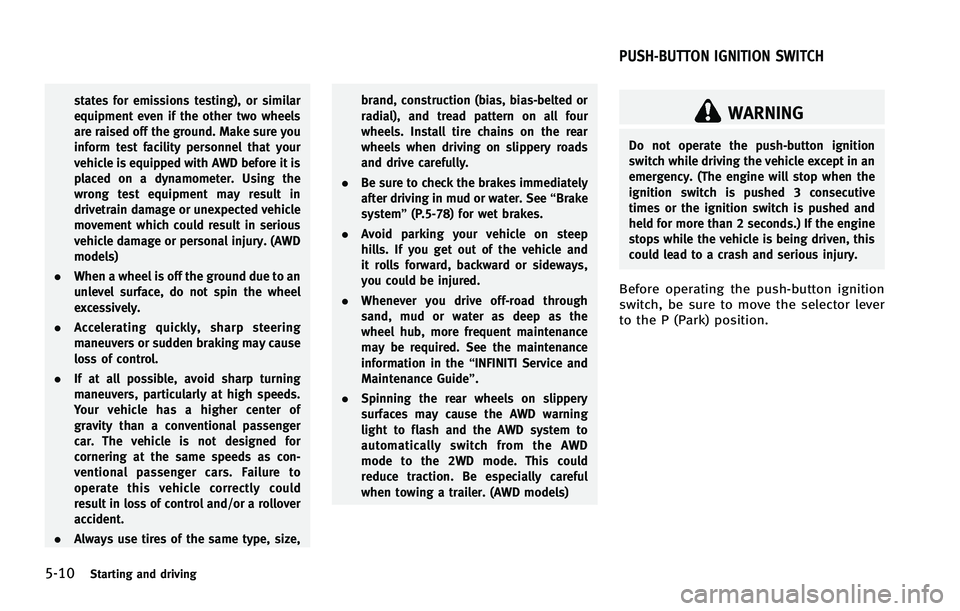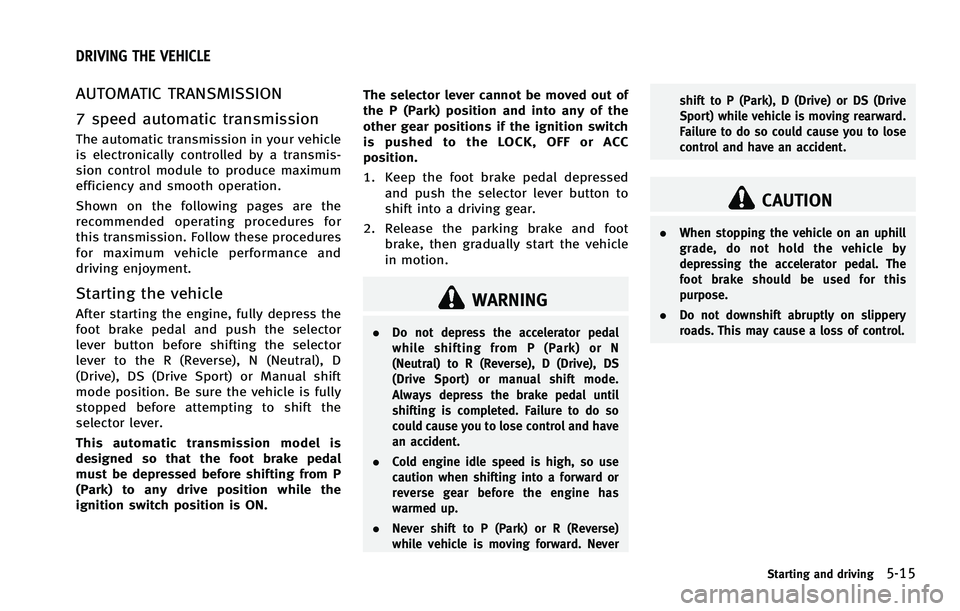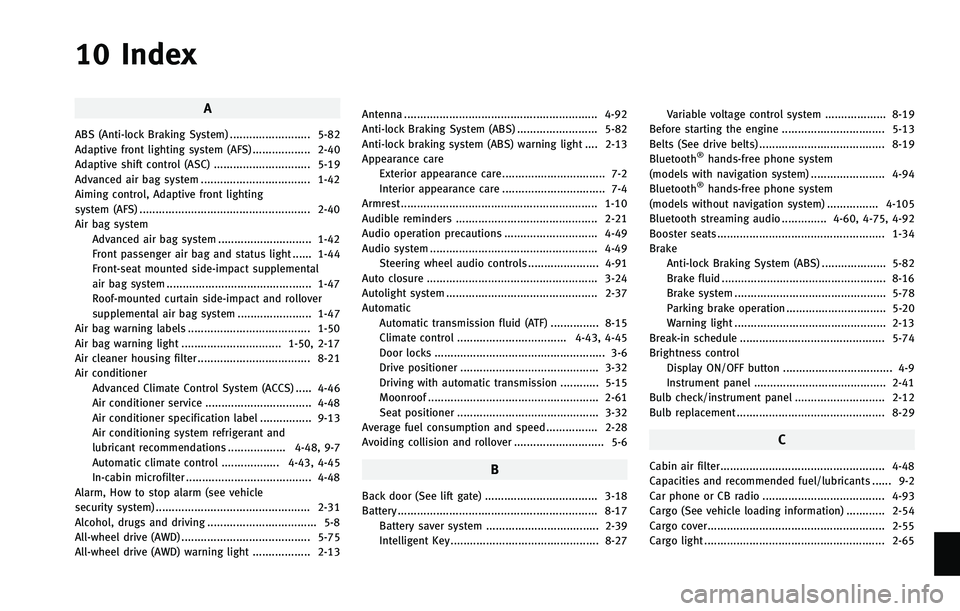start stop button INFINITI FX 2012 User Guide
[x] Cancel search | Manufacturer: INFINITI, Model Year: 2012, Model line: FX, Model: INFINITI FX 2012Pages: 522, PDF Size: 3.51 MB
Page 335 of 522

5-10Starting and driving
states for emissions testing), or similar
equipment even if the other two wheels
are raised off the ground. Make sure you
inform test facility personnel that your
vehicle is equipped with AWD before it is
placed on a dynamometer. Using the
wrong test equipment may result in
drivetrain damage or unexpected vehicle
movement which could result in serious
vehicle damage or personal injury. (AWD
models)
. When a wheel is off the ground due to an
unlevel surface, do not spin the wheel
excessively.
. Accelerating quickly, sharp steering
maneuvers or sudden braking may cause
loss of control.
. If at all possible, avoid sharp turning
maneuvers, particularly at high speeds.
Your vehicle has a higher center of
gravity than a conventional passenger
car. The vehicle is not designed for
cornering at the same speeds as con-
ventional passenger cars. Failure to
operate this vehicle correctly could
result in loss of control and/or a rollover
accident.
. Always use tires of the same type, size, brand, construction (bias, bias-belted or
radial), and tread pattern on all four
wheels. Install tire chains on the rear
wheels when driving on slippery roads
and drive carefully.
. Be sure to check the brakes immediately
after driving in mud or water. See “Brake
system” (P.5-78) for wet brakes.
. Avoid parking your vehicle on steep
hills. If you get out of the vehicle and
it rolls forward, backward or sideways,
you could be injured.
. Whenever you drive off-road through
sand, mud or water as deep as the
wheel hub, more frequent maintenance
may be required. See the maintenance
information in the “INFINITI Service and
Maintenance Guide”.
. Spinning the rear wheels on slippery
surfaces may cause the AWD warning
light to flash and the AWD system to
automatically switch from the AWD
mode to the 2WD mode. This could
reduce traction. Be especially careful
when towing a trailer. (AWD models)WARNING
Do not operate the push-button ignition
switch while driving the vehicle except in an
emergency. (The engine will stop when the
ignition switch is pushed 3 consecutive
times or the ignition switch is pushed and
held for more than 2 seconds.) If the engine
stops while the vehicle is being driven, this
could lead to a crash and serious injury.
Before operating the push-button ignition
switch, be sure to move the selector lever
to the P (Park) position.
PUSH-BUTTON IGNITION SWITCH
Page 339 of 522

5-14Starting and driving
1. Apply the parking brake.
2. Move the selector lever to the P (Park)or N (Neutral) position. (P is recom-
mended.)
The starter is designed not to operate
unless the selector lever is in either of
the above positions.
3. Push the ignition switch to the ON position. Depress the brake pedal and
push the ignition switch to start the
engine.
To start the engine immediately, push
and release the ignition switch while
depressing the brake pedal with the
ignition switch in any position.
.If the engine is very hard to start inextremely cold weather or when
restarting, depress the accelerator
pedal a little (approximately 1/3 to
the floor) and while holding, crank
the engine. Release the accelerator
pedal when the engine starts.
.If the engine is very hard to startbecause it is flooded, depress the
accelerator pedal all the way to the
floor and hold it. Push the ignition
switch to the ON position to start
cranking the engine. After 5 or 6
seconds, stop cranking by pushing the ignition switch to OFF. After
cranking the engine, release the
accelerator pedal. Crank the engine
with your foot off the accelerator
pedal
by depressing the brake pedal
and pushing the push-button igni-
tion switch to start the engine. If the
engine starts, but fails to run, repeat
the above procedure.
CAUTION
Do not operate the starter for more than 15
seconds at a time. If the engine does not
start, push the ignition switch to OFF and
wait 10 seconds before cranking again,
otherwise the starter could be damaged.
4. Warm-up
Allow the engine to idle for at least 30
seconds after starting. Do not race the
engine while warming it up. Drive at
moderate speed for a short distance
first, especially in cold weather. In cold
weather, keep the engine running for a
minimum of 2 - 3 minutes before
shutting it off. Starting and stopping
the engine over a short period of time
may make the vehicle more difficult to start.
5. To stop the engine, shift the selector lever to the P (Park) position and push
the ignition switch to the OFF position.
STARTING THE ENGINE
Page 340 of 522

AUTOMATIC TRANSMISSION
7 speed automatic transmission
The automatic transmission in your vehicle
is electronically controlled by a transmis-
sion control module to produce maximum
efficiency and smooth operation.
Shown on the following pages are the
recommended operating procedures for
this transmission. Follow these procedures
for maximum vehicle performance and
driving enjoyment.
Starting the vehicle
After starting the engine, fully depress the
foot brake pedal and push the selector
lever button before shifting the selector
lever to the R (Reverse), N (Neutral), D
(Drive), DS (Drive Sport) or Manual shift
mode position. Be sure the vehicle is fully
stopped before attempting to shift the
selector lever.
This automatic transmission model is
designed so that the foot brake pedal
must be depressed before shifting from P
(Park) to any drive position while the
ignition switch position is ON.The selector lever cannot be moved out of
the P (Park) position and into any of the
other gear positions if the ignition switch
is pushed to the LOCK, OFF or ACC
position.
1. Keep the foot brake pedal depressed
and push the selector lever button to
shift into a driving gear.
2. Release the parking brake and foot brake, then gradually start the vehicle
in motion.WARNING
. Do not depress the accelerator pedal
while shifting from P (Park) or N
(Neutral) to R (Reverse), D (Drive), DS
(Drive Sport) or manual shift mode.
Always depress the brake pedal until
shifting is completed. Failure to do so
could cause you to lose control and have
an accident.
. Cold engine idle speed is high, so use
caution when shifting into a forward or
reverse gear before the engine has
warmed up.
. Never shift to P (Park) or R (Reverse)
while vehicle is moving forward. Never shift to P (Park), D (Drive) or DS (Drive
Sport) while vehicle is moving rearward.
Failure to do so could cause you to lose
control and have an accident.
CAUTION
.
When stopping the vehicle on an uphill
grade, do not hold the vehicle by
depressing the accelerator pedal. The
foot brake should be used for this
purpose.
. Do not downshift abruptly on slippery
roads. This may cause a loss of control.
Starting and driving5-15
DRIVING THE VEHICLE
Page 341 of 522

5-16Starting and driving
SSD0774
Selector lever
To move the selector lever,
: Push the button while depressing the brake pedal,
: Push the button,
: Just move the selector lever.
Shifting
After starting the engine, fully depress the
brake pedal and shift the selector lever
from P (Park) to R (Reverse), N (Neutral), D
(Drive), DS (Drive Sport) or Manual shift
mode position.
Push the button to shift into P (Park) or R
(Reverse). All other positions can be
selected without pushing the button.
WARNING
Apply the parking brake if the selector lever
is in any position while the engine is not
running. Failure to do so could cause the
vehicle to move unexpectedly or roll away
and result in serious personal injury or
property damage.
CAUTION
Make sure the vehicle is completely stopped
and the transmission is in the P (Park)
position.
P (Park) position:
Use this selector position when the vehicle
is parked or when starting the engine.
Make sure the vehicle is completely
stopped. The brake pedal must be de-
pressed and the selector lever button
pushed in to move the selector lever from
the N (Neutral) position or any drive
position to the P (Park) position. Apply
the parking brake. When parking on a hill,
apply the parking brake first, then move the selector lever to the P (Park) position.
CAUTION
Use this position only when the vehicle is
completely stopped.
R (Reverse):
Use this position to back up. Always be
sure the vehicle is completely stopped
before selecting the R (Reverse) position.
The brake pedal must be depressed and
the selector lever button pushed in to
move the selector lever from the P (Park)
position, the N (Neutral) position or any
drive position to the R (Reverse) position.
N (Neutral):
Neither forward nor reverse gear is en-
gaged. The engine can be started in this
position. You may shift to the N (Neutral)
position and restart a stalled engine while
the vehicle is moving.
D (Drive):
Use this position for all normal forward
driving.
Page 512 of 522

10 Index
A
ABS (Anti-lock Braking System) ......................... 5-82
Adaptive front lighting system (AFS) .................. 2-40
Adaptive shift control (ASC) .............................. 5-19
Advanced air bag system .................................. 1-42
Aiming control, Adaptive front lighting
system (AFS) ..................................................... 2-40
Air bag system
Advanced air bag system ............................. 1-42
Front passenger air bag and status light ...... 1-44
Front-seat mounted side-impact supplemental
air bag system ............................................. 1-47
Roof-mounted curtain side-impact and rollover
supplemental air bag system ....................... 1-47
Air bag warning labels ...................................... 1-50
Air bag warning light ............................... 1-50, 2-17
Air cleaner housing filter ................................... 8-21
Air conditioner Advanced Climate Control System (ACCS) ..... 4-46
Air conditioner service ................................. 4-48
Air conditioner specification label ................ 9-13
Air conditioning system refrigerant and
lubricant recommendations .................. 4-48, 9-7
Automatic climate control .................. 4-43, 4-45
In-cabin microfilter ....................................... 4-48
Alarm, How to stop alarm (see vehicle
security system) ................................................ 2-31
Alcohol, drugs and driving .................................. 5-8
All-wheel drive (AWD) ........................................ 5-75
All-wheel drive (AWD) warning light .................. 2-13 Antenna ............................................................ 4-92
Anti-lock Braking System (ABS) ......................... 5-82
Anti-lock braking system (ABS) warning light .... 2-13
Appearance care
Exterior appearance care ................................ 7-2
Interior appearance care ................................ 7-4
Armrest ............................................................. 1-10
Audible reminders ............................................ 2-21
Audio operation precautions ............................. 4-49
Audio system .................................................... 4-49 Steering wheel audio controls ...................... 4-91
Auto closure ..................................................... 3-24
Autolight system ............................................... 2-37
Automatic Automatic transmission fluid (ATF) ............... 8-15
Climate control .................................. 4-43, 4-45
Door locks ..................................................... 3-6
Drive positioner ........................................... 3-32Driving with automatic transmission ............ 5-15
Moonroof ..................................................... 2-61
Seat positioner ............................................ 3-32
Average fuel consumption and speed ................ 2-28
Avoiding collision and rollover ............................ 5-6
B
Back door (See lift gate) ................................... 3-18 Battery .............................................................. 8-17 Battery saver system ................................... 2-39
Intelligent Key .............................................. 8-27 Variable voltage control system ................... 8-19
Before starting the engine ................................ 5-13
Belts (See drive belts) ....................................... 8-19
Bluetooth
®hands-free phone system
(models with navigation system) ....................... 4-94
Bluetooth
®hands-free phone system
(models without navigation system) ................ 4-105
Bluetooth streaming audio .............. 4-60, 4-75, 4-92
Booster seats .................................................... 1-34
Brake Anti-lock Braking System (ABS) .................... 5-82
Brake fluid ................................................... 8-16
Brake system ............................................... 5-78
Parking brake operation ............................... 5-20
Warning light ............................................... 2-13
Break-in schedule ............................................. 5-74
Brightness control
Display ON/OFF button .................................. 4-9
Instrument panel ......................................... 2-41
Bulb check/instrument panel ............................ 2-12
Bulb replacement .............................................. 8-29
C
Cabin air filter ................................................... 4-48
Capacities and recommended fuel/lubricants ...... 9-2
Car phone or CB radio ...................................... 4-93
Cargo (See vehicle loading information) ............ 2-54
Cargo cover....................................................... 2-55
Cargo light ........................................................ 2-65